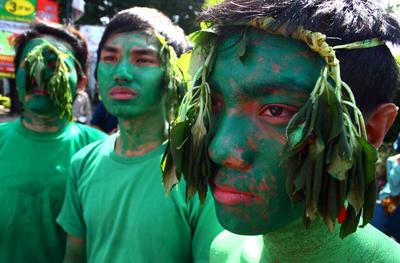These were two presidential decrees concerning forests and the most recent economic development master plan.
If not properly guided, managed and implemented, these three policies have the potential to be contradictory and hence could ruin a significant chance for Indonesia to sustainably manage its remaining valuable forests.
For instance, on 20 May, President Susilo Bambang Yudhoyono signed a presidential instruction number regarding a two-year moratorium on new permits to clear primary forests and peatland throughout Indonesia. This long-awaited moratorium, which was intended to reduce deforestation, may provide a relative degree of certainty for pushing the overall program of reducing emissions from deforestation and forest degradation (REDD+) and land use management and development in Indonesia.
But the decree has been met with polarised reactions and many believe it is a product of a heavy compromise.
The first issue to be debated has been the clarity of figures used as the basis for the moratorium. According to recent government data, which may be based on an indicative map attached to the moratorium document, the moratorium would cover 64.2 million hectares of primary forests and 24.5 million hectares of peatland.
These figures appear to contradict earlier figures released by the government.
In February 2010, for example, the Forestry Minister himself stated that the remaining amount of primary forest in Indonesia was 43 million hectares.
In addition, the National Working Group on Peatland Management, a government taskforce led by the Home Ministry, estimated that in 2006 Indonesia had around 20 million hectares of peatland, distributed mainly in Sumatra, Kalimantan and Papua.
Another important aspect that needs to be scrutinised is that a significant percentage of the primary forests are already protected under Indonesian laws in the form of national parks and other conservation areas. Several conservation organisations have said the moratorium will extend protection to only an additional 14 per cent of primary forests.
A critical dimension to this decree is that it only prohibits the issuance of new permits for logging, conversion and different types of exploitation of primary forests and peatlands.
The challenging question now is to calculate the size of areas of primary forests and peatlands that are already under old and existing concessions, or areas listed under ‘vital’ development programs excluded by this moratorium, as stipulated in the decree.
We may all be surprised to see the exact number and size of these permits.
Another presidential decree released the day before, on 19 May, allowing conditional underground mining in protected forest areas, for example, could further cloud the definition of what are regarded as ‘vital’ activities that can continue to operate in primary forests. Not only does the decree allow geothermal activities to be developed, but also possibly encourage other destructive mining activities to take place.
Furthermore, critics say the presidential instruction covers only primary forests and peatland, leaving out secondary forests. Secondary forests in Indonesia cover an area of more than 20 million hectares and these areas have been constantly threatened by both legal and illegal logging activities and clearing for agricultural or industrial purposes.
If the government is serious about its commitment to reduce Indonesia’s greenhouse gas emissions by 26 per cent, it needs to comprehensively take into account its efforts in avoiding deforestation in primary and secondary forests as well as peatlands.
A crucial aspect which seems to have been left out is support for actors, sectors, regions or communities negatively impacted by the moratorium. That support could take the form of alternative economic schemes that give opportunities via technological or financial means.
The government needs to send a clear signal, particularly to those who stand to lose as result of the moratorium, that they will be treated fairly. There is a huge opportunity to use the Master Plan for the Acceleration and Expansion of Indonesia’s Economic Development (MP3EI) to tackle this challenge.
The government has informed the public it will invest around Rp 200 trillion (US$23.4 billion) to develop six economic corridors promoting palm oil, rubber and other industries under the MP3EI program. If it utilises the MP3EI funding carefully, the government could assist planters, loggers and other land users to achieve more efficient and productive output when it comes to utilising their land.
In the case of palm oil, according to a study conducted in 2007, if oil palm plantation productivity can be improved, there would be no need for the oil palm plantation sector to further expand its land usage, as growth in demand could be met by improving yields of existing plantations by 1.5-2.0 per cent per year.
This intervention could potentially reduce the need to convert forests and peatlands to oil palm plantation.
If this opportunity is ignored and the MP3EI program is not synergised with the moratorium and vice versa, the parties not benefiting from the moratorium will use the economic development master plan as an excuse to continue their ‘business-as-usual’ activities.
If this is the case, Indonesia and its people will still be struggling to achieve balanced development, promoting economic development on the one hand and taking care of the environment on the other. As citizens of this country, we need to ensure that the government and influential parties make the right decision and that the Environment Day we celebrate this year is meaningful.
Fitrian Ardiansyah is a doctoral candidate at the Australian National University, and the recipient of the Australian Leadership Award and Allison Sudradjat Award.
An earlier version of this piece was published here by the Jakarta Post.

